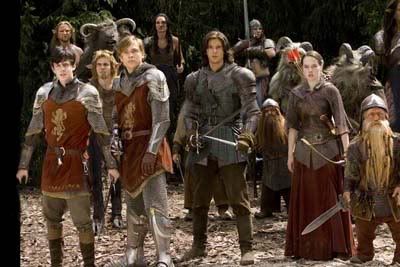
It has been a year for the four Pevensie children at home in England, a millennium and more for the inhabitants of the magical land of Narnia, and two and a half years for anyone in our world waiting for The Chronicles of Narnia: Prince Caspian, the sequel to 2005's The Chronicles of Narnia: The Lion, the Witch and the Wardrobe. Peter (William Moseley), Susan (Anna Popplewell), Edmund (Skandar Keynes) and Lucy (Georgie Henley) have grown up a great deal since their first adventure, when they defeated the evil White Witch and became kings and queens of Narnia. Best of all, director Andrew Adamson has matured just as much as a filmmaker.
The Lion, the Witch and the Wardrobe was a fairy tale; Prince Caspian is a war movie, albeit in a mostly bloodless, PG-type of way. It is a darker, grimmer tale with a militaristic bent reminiscent of The Lord of the Rings: The Return of the King. It doesn't reach the heights of that cinematic landmark, but it is not a stretch to say it is the best fantasy film in the nearly five years since its release.
One of the keys is that Prince Caspian is largely about the people who call Narnia home. It looks as gritty and real to us as it is to them. The action begins here, with the birth of a son to Miraz (a wicked Sergio Castellitto), an usurper to the throne who now has an heir and, thus, a reason to eliminate his nephew, Prince Caspian (Ben Barnes), the rightful king. Warned by his tutor, Caspian flees to the woods, where he knows his uncle's soldiers will be loathe to follow. To his amazement, he finds that the stories of the Old Narnians—talking beasts, dwarves and the like—are more than stories after all. In a moment of confusion, Caspian sends out a magical call for help, summoning the kings and queens of old.
Caspian's call whisks away Peter, Susan, Edmund and Lucy from a train station in England and deposits them at the ruins of the castle from which they once ruled. The dwarf Trumpkin (the always wonderful Peter Dinklage), nicknamed the “D.L.F.” (”Dear Little Friend”) by Lucy, leads them to the woods, where Caspian has raised an army of Narnians to stand against the legions he knows Miraz will send. The Pevensies, especially young Lucy, hold out hope that the great lion Aslan will come to their aid, though few believe he still exists.
Adamson and his fellow co-screenwriters, Christopher Markus and Stephen McFeely, have done a superb job of adapting the C.S. Lewis novel. They compress the narrative at the beginning, eliminating the need later for what would have been a long, problematic flashback. They also beef up the action (an entirely new battle is a welcome addition), stir up a little conflict between Caspian and the High King Peter, and throw in a sprinkling of romance.
The talking animals that helped make The Lion, the Witch and the Wardrobe too cute for its own good are back, though they are used far more effectively. They are soldiers in Caspian's army, and the wise badger Trufflehunter (voice of Ken Stott) becomes a trusted advisor. Eddie Izzard steals all of his scenes as the voice of the noble warrior mouse Reepicheep. The creatures are cuddly, but parents be warned: This is an intense movie and not for the little ones.
Despite the changes and additions, Prince Caspian, like The Lion, the Witch and the Wardrobe, is true to Lewis. The difference is this time the filmmakers found ways to improve the story for its transition to the screen. From the opening chase sequence through the epic, climactic battle, there is an excitement, energy and urgency to all that occurs. It makes the earlier film seem even duller by comparison.
There are five more installments in the Narnia series. If Prince Caspian is any indication, there is the potential for greatness should the remaining chapters follow it to the screen.
GRADE: B+
(Rated PG for epic battle action and violence. 140 minutes.)
No comments:
Post a Comment